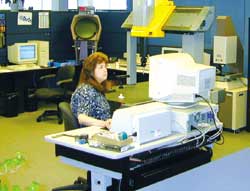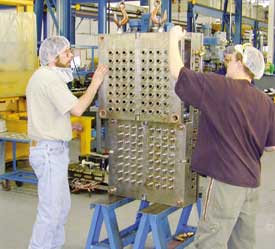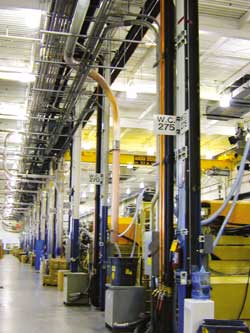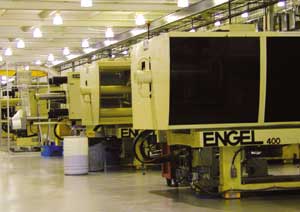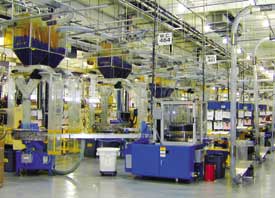May 27, 2002
|
With minimal downtime, Hoop Roche, chairman/ceo of Erie Plastics, moved 64 presses, including eight new 440-ton Huskys, into a new, $15 million facility in three just weeks. |
Erie Plastics celebrated its 40th anniversary last November with the dedication of its new global HQ and manufacturing facility in Corry, PA. The celebration drew 5000 well-wishers and dignitaries with one notable exception. P.C. "Hoop" Roche, chairman and ceo, says an old high school chum of his was unable to make the party—Tom Ridge, the former governor of Pennsylvania. Understandably, Ridge was too busy at his new job, director of homeland security, to attend the ribbon cutting.
Privately held Erie Plastics moved from its 159,000-sq-ft Corry plant into its new 465,000-sq-ft facility in only three weeks. Remarkably, it sustained 60 percent of normal production during the move. Inventories were built way ahead of the time the trucks started rolling. According to Ron Walters—president, coo, a 36-year company vet, and a Corry native—the move was carried out with clockwork precision.
Ten 80,000- to 210,000-lb silos were installed, along with a rail siding to receive raw materials. More than 60 presses were trucked right into position, along with 400 auxiliaries, and about 60 automated decorating and assembly devices. The central air-conditioning/air-filtration system was installed by helicopter.
Roche says he purchased the abandoned factory that Erie Plastics now calls home a few years ago for just $1.00/sq ft. Today, $15 million later, it produces tens of millions of high-quality, thin-wall packaging and medical/pharmaceutical products around the clock with minimal human intervention. "Molding affordable solutions" is the company's mission statement. Want to see how they do it? Let's tour.
Innovation Central
Erie Plastics' move included the renovation of a 35,000-sq-ft corporate office building. Upstairs are conference rooms, video conference rooms, administrative offices, an auditorium, and training centers. Downstairs is its Customer Product Innovation Center (CPIC), which includes a sampling lab for testing prototype tooling and new designs.
The CPIC helps Erie Plastics speed its customers' products to market through concurrent engineering and a team approach to problem solving among its 20 members. Sales, customer service, and engineering all are in one department to facilitate teamwork. Such job function colocation is found throughout the facility.
|
The CPIC's QA lab is equipped with everything from programmable optical measurement systems from OGP and Nikon to a Kayness melt indexer for testing incoming resin. |
Several different 2-D and 3-D design and modeling CAD/CAM systems are used at the CPIC, including Pro/E, AutoCAD, and Intergraph EMS. They also are used on portable computers onsite at customers' facilities as part of Erie Plastics' mobile "Design-a-bago" service. Back in Corry, there's even a Stratasys FDM RP system in the CPIC office for creating 3-D hard copies of 3-D models.
QA and continuous improvement are company cornerstones. Its quality systems operate on ISO 9000 standards. QA engineering works as one with the CPIC project leader to quickly transition jobs through the qualification cycle to production.
Manufacturing-driven SPC supported by the latest Infinity in-process product evaluation software packages linked to real-time process monitoring systems round-out the picture. No one at the Corry plant is ever out of the loop, art to part. Neither are customers.
Wide-open, upfront integration and communication works. For example, Erie Plastics is the only supplier to have won Gillette's Omni Mark award for on-time delivery with zero rejects 13 years in a row. And it did that before moving into its new and improved facility.
Jet-propelled Production
On our way to the manufacturing floor we see ample evidence of how well people are treated in the plant. Rather than bulletin boards, there are interactive TV monitors displaying the FAQs (frequently asked questions) of life in and around the factory, along with the answers. Erie Plastics is a union shop.
Vital Stats Annual sales: $85 million, including tooling Markets served: Packaging (mostly caps and closures)pharmaceutical/medical, pens and markers Customers: Proctor & Gamble, Wyeth Pharmaceuticals, Alcoa, and Colgate Capital investment: $15 million Resin consumption: More than 60 million lb/year No. of employees: 500 Molding machines: 64, 60 to 550 tons, Engel (34), Husky (21), Milacron Secondary operations: Stacking/packing, printing, gluing, tamper band scoring, artificial vision inspection, fully automated high-speed assembly Internal moldmaking: No |
A full-time company nurse is on staff. Shift crews have their own meeting and exercise rooms. The company has a laser-acupuncture program in place to help members stop smoking. A doctor visits weekly and a chiropractor comes in every other week. There's even a half-mile indoor walking track around the shop floor.
The 430,000-sq-ft factory is equally split between manufacturing and finished parts warehousing. Large support departments for maintenance, technical service, tooling, and automation also are in the factory. After donning a hairnet and stepping onto the floor, one word comes to mind: "Wow!"
From the big windows, the half-dozen 5- and 10-ton overhead cranes, and the banks of bright lights on the 32-ft-high ceiling down to the sparkling urethane-coated stonehard flooring, it's immediately apparent that Erie Plastics isn't just aesthetically appealing, it's efficient. And it's jet propelled.
Unlike other plants, the parts at Erie Plastics are pneumatically conveyed, too, not just the pellets. After ejection, parts are pneumatically conveyed through wear- and static-resistant butyrate tubes either directly to packing stations or to highly automated secondaries.
We see tips for bottled water spouts molded on one press, dust caps molded on another, and screw closures molded on still another machine conveyed to a single, fully automated finishing/assembly/packaging station. That's what goes on out there, 24/7. Erie Plastics does up to 24 inventory turns each year—20 to 30 truckloads of finished goods leave its docks every day.
Affordable-solution Molds
"For us, downtime is death," says Roche. To pump up to 30 million parts each day out of presses running on autopilot with little or no human intervention, your molds had better work. That's where the Erie Plastics Tooling Approval Procedure (EPTAP) comes in.
EPTAP confirms the molds it outsources are constructed properly. It identifies a capable process at which molds will produce parts to within key dimensional specs and tolerances. Optimum processing windows also are set. EPTAP is fully supported by QA engineering and the CPIC. An equally rigorous program is in place to qualify and verify the quality of design and workmanship in all of the custom-built, purchased automation equipment.
Erie Plastics has about 300 active molds. All are warranted for at least five years or for five million shots, whichever comes first (10 million shots on second generation). There's a separate grinding room for cold runner scrap, but most of its molds have hot runners, typically from Husky. Still, the company recently won the first Erie Country Guardian of the Planet Earth award for its recycling and waste management activities.
Erie Plastics has instituted what it calls its "Statue of Liberty" mold refurbishment program. Give us your tired, your poor, your huddled tons of fouled-up molds, it says. It promises to improve their production capabilities within 90 days.
Erie Plastics owns and operates another identically jet-propelled, 77,000-sq-ft facility in Westborough, MA, running 32 presses (28 to 500 tons) from Engel, Milacron, and Van Dorn Demag. Erie Plastics also operates sales, engineering, and product development offices in Cincinnati, OH for Midwestern customers.
The company also has four brand-new Huskys on order for its joint venture near Budapest, Hungary—an ISO/QS-certified 45,000-sq-ft plant with 21 molding machines and its own toolroom. Closer to home, the company is eyeing a possible move south to Mexico. Meanwhile, Roche says there's ample room in Corry to add 60 more presses.
|
|
The CPIC sampling lab houses a new three-shot, 100-ton Engel multimolding press; a new, 110-ton, Internet-capable Husky Hylectric hybrid; and a 60-ton Engel tiebarless for smaller molds. | Valve-gated, 128-cavity molds are Erie Plastics' bread and butter. All molds feature a proprietary balancing system designed to ensure that all cavities fill at the same time. |
|
|
Molded parts are pneumatically conveyed to fully automated finishing and assembly stations. | Filtered positive-pressure impellers power the parts handling system. |
|
|
Erie Plastics produces nearly 30 million parts per day on its 64 machines in Corry, PA, including these high-speed Engel packaging machines running high-cavitation molds. | Resin, mostly from Huntsman and Dow Plastics, is pneumatically conveyed from 10 silos through this distribution system to any press on the floor. The closed loop material handling system is from Conair. |
|
|
The company has upgraded the vision systems on its automated decorating and assembly systems, and on error-proofing systems that score several million tamper band caps every day. |
Contact information |
You May Also Like

